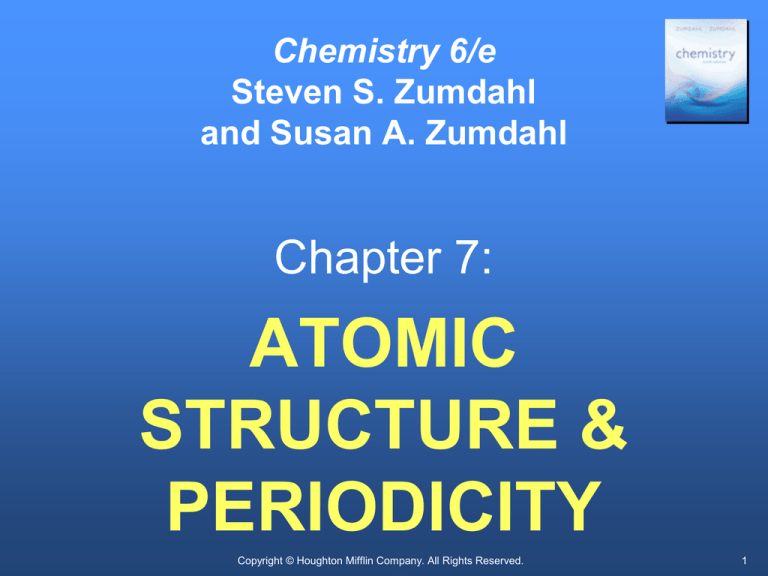
Chemistry 6/e
Steven S. Zumdahl
and Susan A. Zumdahl
Chapter 7:
ATOMIC
STRUCTURE &
PERIODICITY
Copyright © Houghton Mifflin Company. All Rights Reserved.
1
Atomic Structure & Periodicity
• Electromagnetic
Radiation
• React 1
• The Nature of Matter
• The Atomic Spectrum
of Hydrogen
• React 2
• The Bohr Model
• React 3 • 4 • 5
• The Quantum
Mechanical Model of
the Atom
• Orbital Shapes and
Energies
• React 6 • 7 • 8
• Periodic Trends in
Atomic Properties
• React 9 • 10 • 11 • 12
• React 13 • 14 • 15 • 16
• React 17 • 18 • 19 • 20
Copyright © Houghton Mifflin Company. All Rights Reserved.
2
Rutherford’s Model of the Atom
What does Rutherford’s atom “look like”?
We want models to explain our
observations.
Copyright © Houghton Mifflin Company. All Rights Reserved.
3
Rutherford’s Model of the Atom
Copyright © Houghton Mifflin Company. All Rights Reserved.
4
Electromagnetic Radiation
Copyright © Houghton Mifflin Company. All Rights Reserved.
5
Flame Tests
Copyright © Houghton Mifflin Company. All Rights Reserved.
6
Fireworks
Copyright © Houghton Mifflin Company. All Rights Reserved.
7
Questions to Consider
Why do the different chemicals give us
different colors?
Why do we get colors at all?
Copyright © Houghton Mifflin Company. All Rights Reserved.
8
Classification of Electromagnetic Radiation
Copyright © Houghton Mifflin Company. All Rights Reserved.
9
Draw three waves with relative
wavelengths of 1:2:4.
Compare the frequencies and energies of
these wavelengths.
Copyright © Houghton Mifflin Company. All Rights Reserved.
10
The Nature
of Waves
Copyright © Houghton Mifflin Company. All Rights Reserved.
11
Electromagnetic Wave
Copyright © Houghton Mifflin Company. All Rights Reserved.
12
The Nature of Matter
Copyright © Houghton Mifflin Company. All Rights Reserved.
13
Photoelectric Effect
Copyright © Houghton Mifflin Company. All Rights Reserved.
14
The Atomic Spectrum of
Hydrogen
Copyright © Houghton Mifflin Company. All Rights Reserved.
15
Refraction of White Light and
Hydrogen Line Spectrum
Copyright © Houghton Mifflin Company. All Rights Reserved.
16
Explain the hydrogen emission spectrum.
Why is it significant that the color emitted
is not white?
How does the emission spectrum support
the idea of quantized energy levels?
Copyright © Houghton Mifflin Company. All Rights Reserved.
17
The Bohr Model
Copyright © Houghton Mifflin Company. All Rights Reserved.
18
Determine the color of light emitted when
an excited electron in the hydrogen atom
falls from:
I. n = 5 to n = 2
II. n = 4 to n = 2
III. n = 3 to n = 2
Copyright © Houghton Mifflin Company. All Rights Reserved.
19
Electronic Transitions in the Bohr Model for
the Hydrogen Atom
Copyright © Houghton Mifflin Company. All Rights Reserved.
20
There are an infinite number of allowed
transitions in the hydrogen atom.
Why don’t we see more lines in the
emission spectrum for hydrogen?
Copyright © Houghton Mifflin Company. All Rights Reserved.
21
Does a gamma ray of wavelength
1.0 x 10-8 cm have enough energy to
remove an electron from a hydrogen
atom?
Support your answer with calculations.
Copyright © Houghton Mifflin Company. All Rights Reserved.
22
Let’s Think About It
What is the energy associated with a
gamma ray with a wavelength of
1.0 x 10-8 cm?
How much energy does it take to remove
an electron from a hydrogen atom?
Copyright © Houghton Mifflin Company. All Rights Reserved.
23
The Quantum Mechanical
Model of the Atom
Copyright © Houghton Mifflin Company. All Rights Reserved.
24
Probability
Distribution for the
1s Wave Function
Copyright © Houghton Mifflin Company. All Rights Reserved.
25
Radial Probability Distribution
Copyright © Houghton Mifflin Company. All Rights Reserved.
26
Orbital Shapes and Energies
Copyright © Houghton Mifflin Company. All Rights Reserved.
27
Two
Representations of
the Hydrogen 1s,
2s, and 3s Orbitals
Copyright © Houghton Mifflin Company. All Rights Reserved.
28
The Radial
Probability
Distribution for the
3s, 3p, and 3d
Orbitals
Copyright © Houghton Mifflin Company. All Rights Reserved.
29
The Boundary Surface Representations of
All Three 2p Orbitals
Copyright © Houghton Mifflin Company. All Rights Reserved.
30
The Boundary Surfaces of
All of the 3d Orbitals
Copyright © Houghton Mifflin Company. All Rights Reserved.
31
Representation of the 4f Orbitals in Terms of
Their Boundary Surfaces
Copyright © Houghton Mifflin Company. All Rights Reserved.
32
A Comparison of the Radial Probability
Distributions of the 2s and 2p Orbitals
Copyright © Houghton Mifflin Company. All Rights Reserved.
33
The Radial Probability Distribution for the
3s, 3p, and 3d Orbitals
Copyright © Houghton Mifflin Company. All Rights Reserved.
34
Sketch a general orbital-level diagram for
atoms other than hydrogen.
Explain why it differs
from hydrogen.
Copyright © Houghton Mifflin Company. All Rights Reserved.
35
Explain how you can use the periodic
table to determine the order in which
orbitals fill in polyelectronic atoms (so that
you do not have to memorize it).
Copyright © Houghton Mifflin Company. All Rights Reserved.
36
The Orbitals Being Filled for Elements in
Various Parts of the Periodic Table
Copyright © Houghton Mifflin Company. All Rights Reserved.
37
Determine the expected electron
configurations for each of the following:
• S
• Ba
• Ni2+
• Eu
• Ti+
Copyright © Houghton Mifflin Company. All Rights Reserved.
38
Periodic Trends in Atomic
Properties
Copyright © Houghton Mifflin Company. All Rights Reserved.
39
Which is larger, the hydrogen 1s orbital,
or the Li 1s orbital? Why?
Which is lower in energy, the hydrogen 1s
orbital, or the Li 1s orbital? Why?
Copyright © Houghton Mifflin Company. All Rights Reserved.
40
Which atom would require more energy to
remove an electron, Na or Cl? Why?
Copyright © Houghton Mifflin Company. All Rights Reserved.
41
Which atom would require more energy to
remove an electron, Li or Cs? Why?
Copyright © Houghton Mifflin Company. All Rights Reserved.
42
What is the general trend for ionization
energy across rows and down columns on
the periodic table?
Understand this trend; do not merely
memorize it.
Copyright © Houghton Mifflin Company. All Rights Reserved.
43
Which should be the larger atom,
Na or Cl? Why?
Copyright © Houghton Mifflin Company. All Rights Reserved.
44
Which should be the larger atom,
Li or Cs? Why?
Copyright © Houghton Mifflin Company. All Rights Reserved.
45
What is the general trend for atomic size
across rows and down columns on the
periodic table?
Explain this trend.
Copyright © Houghton Mifflin Company. All Rights Reserved.
46
Atomic Radii for
Selected Atoms
Copyright © Houghton Mifflin Company. All Rights Reserved.
47
Arrange the elements oxygen, fluorine,
and sulfur according to increasing
• Ionization energy
• Atomic size
Copyright © Houghton Mifflin Company. All Rights Reserved.
48
The Values of First Ionization Energy for the
Elements in the First Six Periods
Copyright © Houghton Mifflin Company. All Rights Reserved.
49
Explain why the graph of ionization
energy versus atomic number (across a
row) is not linear.
Where are the exceptions?
Why are there exceptions?
Copyright © Houghton Mifflin Company. All Rights Reserved.
50
The ionization energy of the magnesium atom requires 735
kJ/mol. Which of the following is the most accurate
statement about the second ionization energy of Mg?
I.
It is less than 735 kJ/mol because Mg wants to lose
the second electron to have the same electron
configuration as Ne.
II.
It is equal to 735 kJ/mol because both electrons are
being taken from the 3s orbital.
III.
It is greater than 735 kJ/mol because the second
electron is being taken from a positive ion.
IV.
Energy is released when the second electron comes
off because the Mg atom wants to lose the second
electron to have the same electron configuration as
Ne.
Copyright © Houghton Mifflin Company. All Rights Reserved.
51
Relative Ionization Energies for Elements
X
Y
First
170
200
Second
350
400
Third
1800
3500
Fourth
2500
5000
Identify the elements. Why can there be more
than one answer?
Copyright © Houghton Mifflin Company. All Rights Reserved.
52
Which has the larger second ionization
energy, lithium or beryllium?
Why?
Copyright © Houghton Mifflin Company. All Rights Reserved.
53
General decrease
Successive Ionization Energies in Kilojoules
per Mole for the Elements in Period 3
Element
I1
I2
I3
I4
I5
I6
I7
Na
495
4560
Mg
735
1445
7730
Core electrons*
Al
580
1815
2740
11,600
Si
780
1575
3220
4350
16,100
P
1060
1890
2905
4950
6270
21,200
S
1005
2260
3375
4565
6950
8490
27,000
Cl
1255
2295
3850
5160
6560
9360
11,000
Ar
1527
2665
3945
5770
7230
8780
12,000
* Note the large jump in ionization energy in going from removal of valence electrons to
removal of core electrons.
General increase
Copyright © Houghton Mifflin Company. All Rights Reserved.
54







